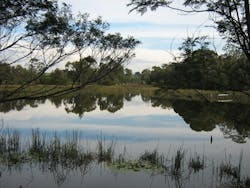USDA to Invest $30 Million to Help Protect Wetlands in Six States
Agriculture Secretary Tom Vilsack announced that the U.S. Department of Agriculture will award $30 million to projects in six states to protect, restore and enhance wetlands on private and tribal agricultural lands. The projects are being funded under the Wetland Reserve Enhancement Partnership (WREP), a program authorized by the 2014 Farm Bill.
"Through locally led partnerships like these, USDA is targeting conservation in the places that make sense, allowing us to address local concerns," Vilsack said. "These projects will improve water quality, prevent flooding, enhance wildlife habitat and meet increasing conservation challenges on over 19,000 acres of wetlands."
Created by the 2014 Farm Bill, WREP is a special enrollment option under the Agricultural Conservation Easement Program's Wetland Reserve Easement component. Through WREP, which is administered by USDA's Natural Resources Conservation Service (NRCS), states, local units of governments, non-governmental organizations and American Indian tribes collaborate with NRCS through cooperative and partnership agreements. These partners work with tribal and private landowners who voluntarily enroll eligible land into easements to protect, restore and enhance wetlands on their properties.
Wetland reserve easements allow landowners to successfully enhance and protect habitat for wildlife on their lands, reduce impacts from flooding, recharge groundwater and provide outdoor recreational and educational opportunities. The voluntary nature of NRCS' easement programs allows effective integration of wetland restoration on working landscapes, providing benefits to farmers and ranchers who enroll in the program, as well as benefits to the local and rural communities where the wetlands exist.
NRCS awarded grants for projects in Iowa, Kentucky, Missouri, Mississippi, Nebraska and Tennessee.
2015-2016 WREP Projects:
- Iowa: Partners will acquire and restore prairie pothole wetlands and associated tallgrass prairie uplands on five sites within Prairie Pothole Joint Venture Priority Areas and Ducks Unlimited Living Lakes Initiative Emphasis Areas. Partner contributions will nearly double the acres of wetlands that will be protected and restored. NRCS plans to invest $3 million in this project.
- Kentucky: Partners will acquire and restore wetlands in high priority small watersheds to reduce sediment and nutrients entering the Mississippi River. Coordination with the Kentucky Indiana Bat Fund, The Nature Conservancy and other partners will provide protection of adjacent forested wetlands, increasing the impacted area and quality of protected habitat provided for wildlife. NRCS plans to invest $9.4 million in this project.
- Mississippi: Partners will expand an existing project to increase the acres acquired and wetlands restored in the Mississippi River Basin. These additional wetland acres will provide habitat for fish and wildlife, improve water quality by filtering sediments and nutrients, reduce flooding, recharge ground water and provide outdoor recreational opportunities. NRCS plans to invest $5.1 million in this project.
- Missouri: Partners will enhance 9,500 acres of existing wetlands and restore 500 acres of critically imperiled wet prairie habitats on existing USDA easements improving a total of 10,000 acres. Strong partner support across 30 counties will build on the success of ongoing conservation easement programs in the state. NRCS plans to invest $2.4 million in this project.
- Nebraska: Additional partners will build on the success of two previous WREP projects to acquire and restore the state's playa wetlands and mixed-grass prairie buffers. By modifying irrigation and grazing practices this project will provide a unique twist on traditional easements with innovative partner input that links production agriculture land with conservation easements. NRCS plans to invest $1.7 million in this project.
- Tennessee: Partners will acquire and restore wetlands in a Hypoxia Task Force priority watershed of the lower Mississippi River, reducing the sediment and nutrients entering the river while improving wildlife habitat. The project area also includes areas along the Mississippi River in Arkansas, Louisiana, Mississippi, Kentucky and Missouri. Twenty-six of the 35 counties in the project area are identified by the USDA as Persistent Poverty StrikeForce Counties, where assistance to combat rural poverty will be targeted. This is the second phase of work that began in 2012 that is on track to enroll 15,000 acres by 2016. NRCS plans to invest $8.4 million in this project.
WREP partners contribute a funding match for financial or technical assistance. These partners work directly with eligible landowners interested in enrolling their agricultural land into conservation wetland easements.
These awards build on the more than $330 million USDA announced in fiscal year 2015 to protect and restore agricultural working lands, grasslands and wetlands. Collectively, NRCS easement programs help productive farm, ranch and tribal lands continue in agricultural production and protect the nation's critical wetlands and grasslands that are important to water supplies and home to diverse wildlife and plant species. Under the former Wetlands Reserve Program, private landowners, tribes and entities such as land trusts and conservation organizations have enrolled 2.7 million acres through 14,500 agreements for a total NRCS and partner investment of $4.3 billion in financial and technical assistance.
Source: USDA
